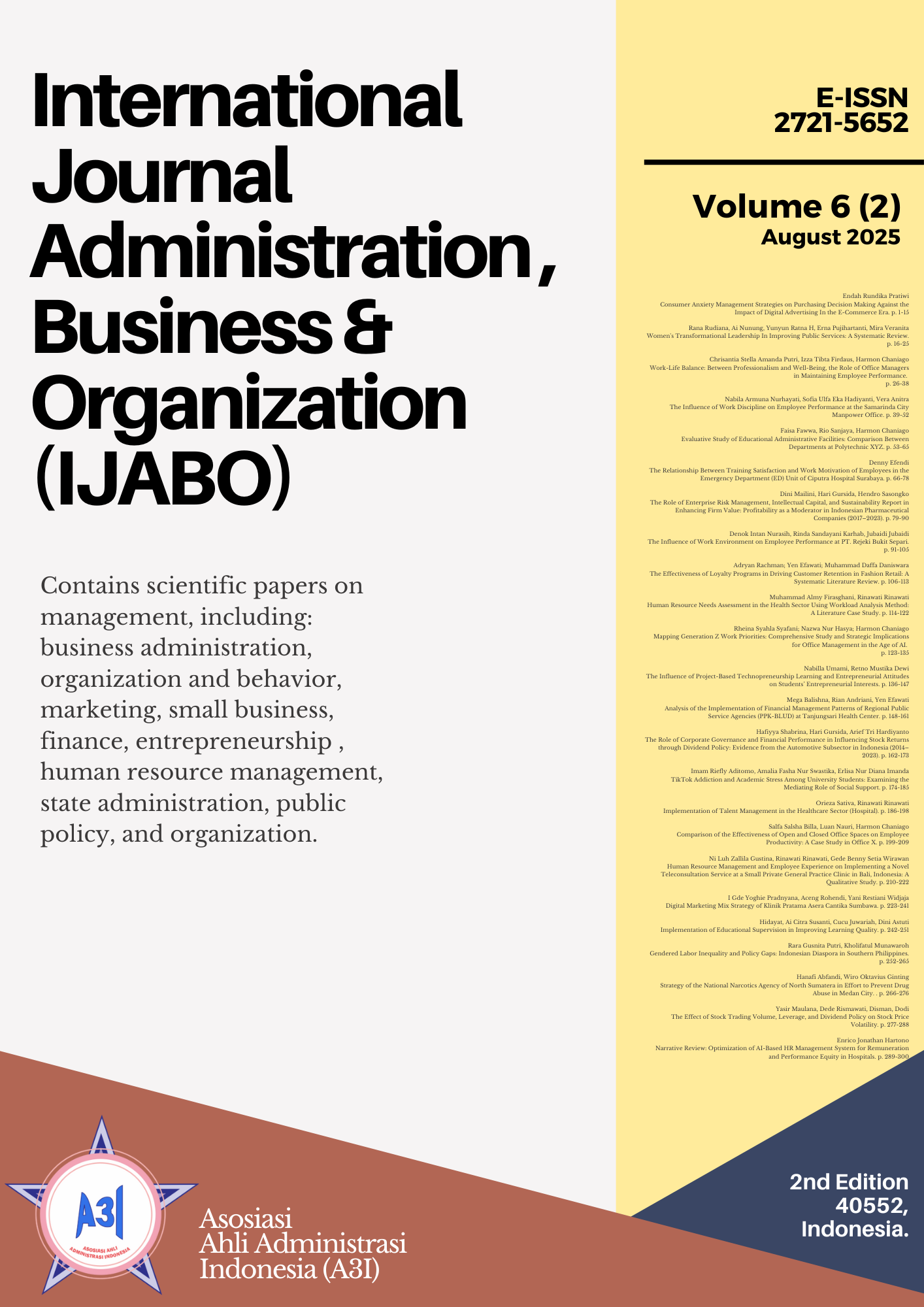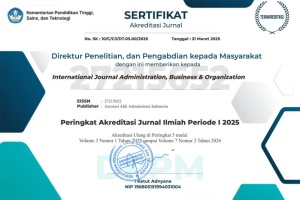Digital Marketing Mix Strategy of Klinik Pratama Asera Cantika Sumbawa
Abstract
The digital era has brought significant changes to marketing strategies, including in the healthcare sector. Klinik Pratama Asera Cantika Sumbawa faces increasingly intense competition, requiring effective marketing strategies to enhance competitiveness and attract more patients. This study aims to analyze the implementation, challenges, and solutions of digital marketing mix strategies to attract and retain customers at Klinik Pratama Asera Cantika Sumbawa. This research employs a qualitative approach using observation and focused interviews. The study's informants include the marketing team and social media team of Klinik Pratama Asera Cantika Sumbawa. The researcher focuses on the implementation of the P-based digital marketing mix strategy, as well as the factors that hinder and support its success in reaching the target market. The findings indicate that Klinik Pratama Asera Cantika Sumbawa has comprehensively implemented the digital marketing mix strategy using the P approach, covering product, price, place, promotion, process, people, and physical evidence. However, internal challenges such as budget constraints in marketing communication, difficulties in building customer loyalty due to intense competition, and accessibility and service convenience issues remain major obstacles in optimizing digital strategies. To address these challenges, the clinic has adopted various solutions, including online consultation systems, social media and influencer-based promotional strategies, and improvements in facilities and services to enhance customer experience. By implementing more focused and adaptive strategies, the clinic aims to strengthen its competitive advantage and maintain customer loyalty amid the increasingly competitive beauty industry.
References
Abrar, A., Khan, M. N., & Khan, S. (2016). Impact of marketing mix on consumer buying behavior: An empirical analysis. International Journal of Economics, Commerce and Management, 4(11), 101–114.
Adoli, J. M., & Kilika, J. M. (2020). Marketing strategy and organizational performance: A review of literature. International Journal of Business and Management, 15(1), 1–10.
Alwinie, A. A., Nurhayati, P., & Sartono, B. (2024). The role of 7P marketing mix toward consumer satisfaction and loyalty of XYZ Beauty Clinic. Journal of Consumer Sciences, 9(1), 40–62.
Arief, M. (2016). Pemasaran jasa: Konsep dan strategi. Yogyakarta: CV. Andi Offset.
Armiani, A., Suharyono, & Yulianto, A. (2024). The influence of digital marketing and brand image on purchase decisions with brand trust as an intervening variable. International Journal of Business and Management Invention, 13(1), 1–10.
Bag, S., Gupta, S., & Kumar, S. (2022). Digital marketing and consumer behavior: A review and research agenda. Journal of Marketing Analytics, 10(1), 1–15.
Batra, R., & Keller, K. L. (2016). Integrating marketing communications: New findings, new lessons, and new ideas. Journal of Marketing, 80(6), 122–145.
Belch, G. E., & Belch, M. A. (2018). Advertising and promotion: An integrated marketing communications perspective. New York: McGraw-Hill Education.
Bitner, M. J. (1992). Servicescapes: The impact of physical surroundings on customers and employees. Journal of Marketing, 56(2), 57–71.
Bolton, R. N., Lemon, K. N., & Verhoef, P. C. (2018). The theoretical underpinnings of customer experience management. Journal of the Academy of Marketing Science, 46(1), 1–18.
Booms, B. H., & Bitner, M. J. (1981). Marketing strategies and organization structures for service firms. Marketing of Services, 25(3), 47–52.
Cavallo, A., Ghezzi, A., & Balocco, R. (2021). The role of marketing strategy in digital transformation: A systematic literature review. Journal of Business Research, 122, 552–566.
Chaffey, D., & Ellis-Chadwick, F. (2019). Digital marketing: Strategy, implementation and practice. London: Pearson Education.
Chaniago, H. (2022). The effect innovation cloning to small business success: Entrepreneurial perspective. Journal of Innovation and Entrepreneurship, 11(1), 52.
Chaniago, H., & Efawati, Y. (2022). The implementation of integrated marketing communication on retail business: Moslem consumers' perceptions. International Journal of Business and Globalisation, 30(2), 187-206. https://doi.org/10.1504/IJBG.2022.122664
Creswell, J. W. (2014). Research design: Qualitative, quantitative, and mixed methods approaches. Thousand Oaks: Sage Publications.
Efawati, Y., Rinawati, Andriani, R., Mubarok, A., (2024). Manajemen Strategi. Bandung: Edukasi Riset Digital, PT.
Ekawati, N. W., & Andriani, D. (2022). Marketing mix strategy in hospitals during the Covid-19 pandemic. International Journal of Health Sciences, 6(Special Issue), 1–10.
Ekawati, N. W., & Nuryasti, D. (2023). The influence of digital marketing and service quality on customer satisfaction in beauty clinics. Journal of Business and Management Review, 4(1), 1–10.
Fajrini, R., Wibowo, A., & Astuti, S. (2022). Innovative marketing mix strategy to improve competitiveness of beauty clinics during the pandemic. Journal of Management and Business Review, 19(1), 1–10.
Gartner, J., Maresch, D., & Tierney, R. (2024). The key to scaling in the digital era: Simultaneous automation, individualization and interdisciplinarity. Journal of Small Business Management, 62(2), 628–655.
Greenhalgh, T., et al. (2017). Beyond adoption: A new framework for theorizing and evaluating nonadoption, abandonment, and challenges to the scale-up, spread, and sustainability of health and care technologies. Journal of Medical Internet Research, 19(11), e367.
Hanggraito, A., Wijayanti, A., & Pratiwi, A. (2020). Alternative marketing mix strategy at the Yogyakarta Batik Museum. Journal of Tourism and Hospitality Management, 8(1), 1–10.
Hoyer, W. D., MacInnis, D. J., & Pieters, R. (2020). Consumer behavior. Boston: Cengage Learning.
Ihsannudin, M., Wibowo, A., & Astuti, S. (2022). Implementation of marketing mix in the hotel industry. Journal of Management and Business Review, 19(1), 1–10.
Indah, P. S., Wibowo, A., & Astuti, S. (2024). The influence of marketing mix on consumer interest in visiting a product or service. Journal of Business and Management Review, 5(1), 1–10.
Joshi, S., Singh, A., & Kumar, S. (2022). A study on consumer buying behavior towards beauty and personal care products. International Journal of Management and Humanities, 9(4), 1–10.
Kant, R. (2020). Digital marketing mix: A review. International Journal of Management and Social Sciences Research, 9(1), 1–10.
Kim, Y.-K., & Chung, J.-E. (2011). Consumer behavior in the beauty industry: A cross-cultural study. Journal of Global Fashion Marketing, 2(1), 1–10.
Kotler, P., & Armstrong, G. (2018). Principles of marketing. London: Pearson Education.
Kotler, P., & Keller, K. L. (2016). Marketing management. London: Pearson Education.
Lamb, C. W., Hair, J. F., & McDaniel, C. (2018). MKTG. Boston: Cengage Learning.
Leli, L., Wibowo, A., & Astuti, S. (2023). The role of social media marketing in building brand awareness and purchase intention. Journal of Management and Business Review, 20(1), 1–10.
Lovelock, C., & Wirtz, J. (2016). Services marketing: People, technology, strategy. Singapore: World Scientific Publishing Co.
Malik, S. Y., Cao, Y., Mughal, Y. H., Kundi, G. M., Mughal, M. H., & Ramayah, T. (2020). Pathways towards sustainability in organizations: Empirical evidence on the role of green human resource management practices and green intellectual capital. Sustainability, 12(8), 3228.
Mangold, W. G., & Faulds, D. J. (2009). Social media: The new hybrid element of the promotion mix. Business Horizons, 52(4), 357–365.
McCarthy, J. E. (1960). Basic marketing: A managerial approach. Homewood: Richard D. Irwin.
Mehra, A., & Coleman, J. (2016). The impact of marketing strategy on organizational performance. Journal of Business Research, 69(1), 1–10.
Miles, M. B., & Huberman, A. M. (1994). Qualitative data analysis: An expanded sourcebook. Thousand Oaks: Sage Publications.
Moctezuma, D., & Subramanian, R. (2016). Digital marketing and its impact on transaction costs. Journal of Internet Commerce, 15(1), 1–10.
Mohammed, M., & Korankye, K. (2024). Reducing cost in the public health sector: A case study of Agona Swedru District Hospital (Doctoral dissertation).
Monroe, K. B. (2003). The pricing strategy: How to get the price right. New York: McGraw-Hill.
Mulyadi, R. D. R., & Efawati, Y. (2024). Understanding Consumer Minds: How Psychological Aspects Drive E-commerce Purchases. International Journal Administration, Business & Organization, 5(5), 15-23.
Nuzula, N., Wibowo, A., & Astuti, S. (2024). Marketing mix strategy of Paradise Parisudha Village Clinic, Plosoklaten Kediri in increasing sales volume. Journal of Management and Business Review, 21(1), 1–10.
Patel, V., & Singh, S. (2019). Digital marketing: A review of literature. International Journal of Management, Technology and Engineering, 9(1), 1–10.
Peter, P., & Dalla, V. (2021). The role of social media in digital marketing. International Journal of Management and Marketing Research, 14(1), 1–10.
Pogorelova, E., Pleshkova, A., & Guseva, E. (2016). Digital marketing mix: A new approach to marketing. International Journal of Economic Perspectives, 10(1), 1–10.
Porter, M. E. (1985). Competitive advantage: Creating and sustaining superior performance. New York: Free Press.
Pramadyanto, A. (2022). Digital marketing strategy in the era of Industry 4.0. Journal of Business and Management Review, 3(1), 1–10.
Puspita, Y., & Santoso, A. (2018). Digital marketing strategy for beauty products. Journal of Business and Management, 15(1), 1–10.
Rangaswamy, A., Bitner, M. J., & Parasuraman, A. (2020). The future of service: How technology is transforming customer experience. Journal of Service Research, 23(1), 1–10.
Rosenbloom, B. (2012). Marketing channels. Boston: Cengage Learning.
Ryan, D. (2017). Understanding digital marketing: Marketing strategies for engaging the digital generation. London: Kogan Page Publishers.
Shofwatunida, S., & Nurmawaty, N. (2022). Marketing mix analysis at a clinic. Journal of Management and Business Review, 19(1), 1–10.
Soesilo, S., & Rohendi, A. (2024). The influence of digital marketing on consumer purchase decisions in the beauty industry. Journal of Business and Management Review, 5(1), 1–10.
Spyropoulou, S., Fotiadis, A. K., & Li, G. (2018). Marketing strategy and firm performance: A meta-analysis. Journal of Business Research, 82, 1–10.
Statista. (2024). Beauty & personal care market. Retrieved from https://www.statista.com/outlook/cmo/beauty-personalcare/worldwide
Sunipa, S., & Ehyani, S. (2022). A study on customer satisfaction towards beauty parlor services. International Journal of Research in Commerce, Economics & Management, 12(1), 1–10.
Thariq, F., & Efawati, Y. (2024). The Influence of Website Quality on Buying Interest Consumer. International Journal Administration, Business & Organization, 5(3), 64-74.
Wichmann, J., Müller, O., & O’Cass, A. (2022). The marketing mix in the digital age: A systematic literature review. Journal of Business Research, 145, 1–10.
Widjaja, Y. R., Wibowo, A., & Astuti, S. (2024). The role of marketing mix in achieving business goals. Journal of Management and Business Review, 5(1), 1–10.
Yasmin, A., Tasneem, S., & Fatema, K. (2015). Effectiveness of digital marketing in the challenging age: An empirical study. International Journal of Management Science and Business Administration, 1(5), 69–80.
Zeithaml, V. A., Bitner, M. J., & Gremler, D. D. (2009). Services marketing: Integrating customer focus across the firm. New York: McGraw-Hill Irwin.
Copyright (c) 2025 I Gde Yoghie Pradnyana, Aceng Rohendi, Yani Restiani Widjaja

This work is licensed under a Creative Commons Attribution-ShareAlike 4.0 International License.
Authors who publish in this journal agree to the following terms:
- The authors confirm that they are the authors of the submitted article, which will be published (online) in the journal IJABO (International Journal Administration, Business & Organization) by the Asosiasi Ahli Administrasi Indonesia (A3i), Bandung, Indonesia. The author’s name will be evident in the article. The publisher makes all decisions regarding the layout and distribution of the work.
- Authors guarantee that the work is their own original creation and does not infringe any statutory or common-law copyright or any proprietary right of any third party. In case of claims by third parties, authors commit themself to defend the interests of the publisher and shall cover any potential costs.
- Authors retain copyright and grant the journal the right of first publication, with the work simultaneously licensed under a Creative Commons Attribution-ShareAlike 4.0 International License (CC BY-SA 4.0). This license allows the redistribution and reuse of papers provided the authorship is properly credited.
- Authors can enter into separate, additional contractual arrangements for the non-exclusive distribution of the journal's published version of the work (e.g., posting it to an institutional repository or publishing it in a book), with an acknowledgment of its initial publication in this journal.
- Authors are permitted and encouraged to post their work online (e.g., in institutional repositories or on their website) prior to and during the submission process, as this can lead to productive exchanges and earlier and greater citations of published work.

















